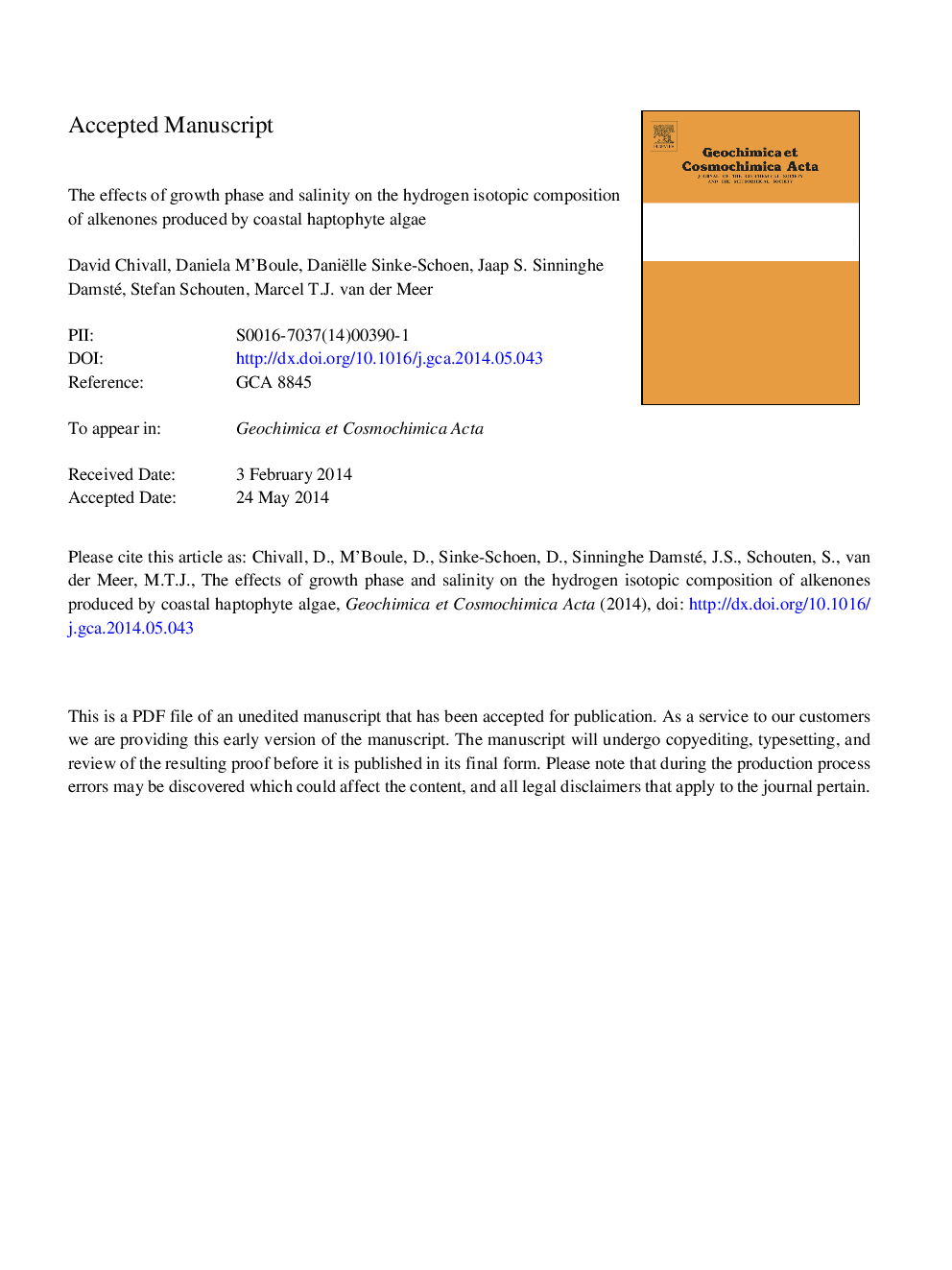| کد مقاله | کد نشریه | سال انتشار | مقاله انگلیسی | نسخه تمام متن |
|---|---|---|---|---|
| 6438378 | 1638017 | 2014 | 28 صفحه PDF | دانلود رایگان |
عنوان انگلیسی مقاله ISI
The effects of growth phase and salinity on the hydrogen isotopic composition of alkenones produced by coastal haptophyte algae
ترجمه فارسی عنوان
اثر فاز رشد و شوری بر ترکیب ایزوتوپ هیدروژن آلکونوئیدهای تولید شده توسط جلبکهای ساحلی هپتوفیت
دانلود مقاله + سفارش ترجمه
دانلود مقاله ISI انگلیسی
رایگان برای ایرانیان
موضوعات مرتبط
مهندسی و علوم پایه
علوم زمین و سیارات
ژئوشیمی و پترولوژی
چکیده انگلیسی
The isotopic fractionation of hydrogen during the biosynthesis of alkenones produced by marine haptophyte algae has been shown to depend on salinity and, as such, the hydrogen isotopic composition of alkenones is emerging as a palaeosalinity proxy. The relationship between fractionation and salinity has previously only been determined during exponential growth, whilst it is not yet known in which growth phases natural haptophyte populations predominantly exist. We have therefore determined the relationship between the fractionation factor, αalkenones-water, and salinity for C37 alkenones produced in different growth phases of batch cultures of the major alkenone-producing coastal haptophytes Isochrysis galbana (strain CCMP 1323) and Chrysotila lamellosa (strain CCMP 1307) over a range in salinity from ca. 10 to 35. αalkenones-water was similar in both species, ranging over 0.841-0.900 for I. galbana and 0.838-0.865 for C. lamellosa. A strong (0.85 ⩽ R2 ⩽ 0.97; p < 0.0001) relationship between salinity and fractionation factor was observed in both species at all growth phases investigated. This suggests that alkenone δD has the potential to be used as a salinity proxy in neritic areas where haptophyte communities are dominated by these coastal species. However, there was a marked difference in the sensitivity of αalkenones-water to salinity between different growth phases: in the exponential growth phase of I. galbana, αalkenones-water increased by 0.0019 per salinity unit (Sâ1), but was less sensitive at 0.0010 and 0.0008 Sâ1 during the stationary and decline phases, respectively. Similarly, in C. lamellosa αalkenones-water increased by 0.0010 Sâ1 in the early stationary phase and by 0.0008 Sâ1 during the late stationary phase. Assuming the shift in sensitivity of αalkenones-water to salinity observed at the end of exponential growth in I. galbana is similar in other alkenone-producing species, the predominant growth phase of natural populations of haptophytes will affect the sensitivity of the alkenone salinity proxy. The proxy is likely to be most sensitive to salinity when alkenones are produced in a state similar to exponential growth.
ناشر
Database: Elsevier - ScienceDirect (ساینس دایرکت)
Journal: Geochimica et Cosmochimica Acta - Volume 140, 1 September 2014, Pages 381-390
Journal: Geochimica et Cosmochimica Acta - Volume 140, 1 September 2014, Pages 381-390
نویسندگان
David Chivall, Daniela M'Boule, Daniëlle Sinke-Schoen, Jaap S. Sinninghe Damsté, Stefan Schouten, Marcel T.J. van der Meer,
